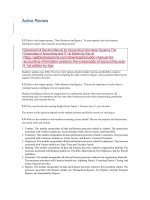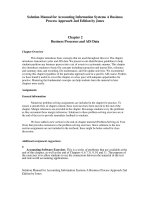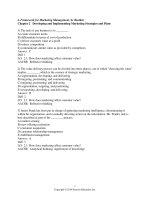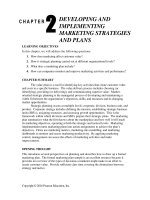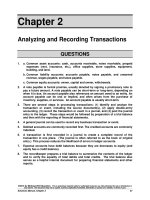Test bank and solution manual for CH03 market and the market process (2)
Bạn đang xem bản rút gọn của tài liệu. Xem và tải ngay bản đầy đủ của tài liệu tại đây (351.92 KB, 6 trang )
CHAPTER 2
Markets and the Market Process
FUNDAMENTAL QUESTIONS
1.
How are goods and services allocated?
2.
How does the market process work?
3.
What is demand?
4.
What is supply?
5.
How is price determined by demand and supply?
6.
What causes price to change?
TEACHING OBJECTIVES
The purpose of this chapter is twofold. The first is to introduce the different allocation mechanism
systems, and the second is to develop the concepts of demand and supply and explain how they
combine to produce equilibrium prices and quantities.
The unique features of this chapter are the explanation of the functioning of the market process and a
discussion of market equilibrium in the real world.
The concepts that warrant special coverage are the construction of demand and supply curves, how a
movement along one curve compares to a shift in the entire curve, and how equilibrium prices and
quantities are obtained. Reasons for changes in equilibrium prices are also shown as shifts in the
demand and/or supply curves.
KEY TERMS
efficiency
demand
law of demand
demand schedule
demand curve
market demand
quantity demanded
determinants of demand
substitute goods
complementary goods
supply
© 2014 Cengage Learning. All Rights Reserved. May not be scanned, copied or duplicated, or posted to a
publicly accessible website, in whole or in part.
12
Chapter 2: Markets and the Market Process
law of supply
determinants of supply
supply schedule
supply curve
equilibrium
surplus
shortage
LECTURE OUTLINE AND TEACHING STRATEGIES
1. How are goods and services allocated?
The ways inputs can be utilized to serve the needs of consumers are called the allocation mechanisms.
The market (price), government, random choice, and the first-come, first-served mechanisms are the
most commonly used allocation mechanisms.
Teaching Strategy: Using the exercise in Preview in the text, survey the class about their response to
the different situations. This is an excellent way of introducing the students to the notion of market
mechanism and other means of allocating resources. You should expect a great deal of debate about the
different allocation mechanisms.
1.
Efficiency: If an allocation mechanism is efficient, it means that it best satisfies the needs and
wants of a society compared to the other allocation mechanisms. A system of markets and prices
is often the most efficient way of allocating scarce resources. As a result, it is predominantly used
in most industrial countries today.
2.
Self-interest: When economists assume people are self-interested, they do not mean people are
mean-spirited or selfish, but are pursuing ends that best suit their needs and wants.
3.
Alternatives to market allocation: In some cases, the market system is not the best. One reason for
this is that for some goods and services, such as health care and defense, people do not like the
outcome of the market system. Another reason is that the market system is inefficient under some
circumstances. When the market is not the best system, the government is often called on to
allocate resources and goods.
Disagreement with the market outcome
Inefficiency
Teaching Strategy: Divide the class into groups and ask each group to make a list of situations where
they consider the market outcome is not efficient. Select one group to share their list with the class and
choose another group to react to the first group’s list. Then repeat the exercise with other groups. At the
end, point out that the market system is not the best available allocation mechanism in some cases,
although it is in most cases.
2. How does the market process work?
A market is defined as a place where buyers and sellers get together and set prices and quantities.
Teaching Strategy: Give real-world examples of markets that students can conceptualize, for example,
the market for X-Box, for illegal drugs, or for a local painter working on a cash-only basis.
© 2014 Cengage Learning. All Rights Reserved. May not be scanned, copied or duplicated, or posted to a
publicly accessible website, in whole or in part.
Chapter 2: Markets and the Market Process
13
The market process guides producers to produce goods and services demanded by consumers at the
lowest possible price. As a result, those firms that cannot use resources most efficiently have to leave
the market. Thus, the market process brings about efficiency and increases consumer welfare. Some
have compared market efficiencies to economic Darwinism: survival of the fittest.
3. What is demand?
1.
The law of demand: The quantity of a well-defined good or service that people are willing and
able to purchase during a particular period of time decreases as the price of that good rises, ceteris
paribus. Be sure to define this term.
There are two points that economists advance to argue for a downward-sloping demand curve—
the income and substitution effects. The income effect takes place when a change in the price of a
good alters the consumers’ purchasing power. When the price of a good changes, and in turn the
demand for a substitute good changes, the substitution effect is at work.
Teaching Strategy: When beer prices fall during a Friday afternoon happy hour, bar patrons
substitute more beer for other goods they could consume (the substitution effect). In addition, the
increase in their purchasing power due to the less expensive beer allows them to buy more
pretzels and pizza (the income effect).
2.
The demand schedule is a list of the quantities of a good that consumers demand at different
prices, ceteris paribus.
Teaching Strategy: Pass out slips of paper and ask students what price they would pay for an A
in the course. Generate a demand schedule with the results.
3.
The demand curve is a graph constructed from the data in the demand schedule.
Teaching Strategy: Derive a demand curve from the demand schedule created in the teaching
strategy above.
4.
A market demand curve is the horizontal summation of all individual demand curves.
5.
Compare a movement along a demand curve, a change in quantity demanded, to a shift in the
entire curve, a change in demand. The determinants of demand are income, tastes, the prices of
related goods, expectations, and the number of buyers.
Teaching Strategy: Consider using a mnemonic to help students appreciate the various forces
that can cause a change in demand: TYPEN.
T = tastes
Y = income
P = price of related goods
E = expectations
N = number of consumers
Teaching Strategy: Ask your students to reconsider their demand for an A after receiving $1,000
in lottery winnings.
4. What is supply?
1.
The law of supply: The quantity of a good producers will sell is positively related to price, ceteris
paribus.
© 2014 Cengage Learning. All Rights Reserved. May not be scanned, copied or duplicated, or posted to a
publicly accessible website, in whole or in part.
14
Chapter 2: Markets and the Market Process
Teaching Strategy: Focus the law of supply around the profit motive of producers, that is, selfinterest.
2.
The supply curve is composed of all the combinations of prices and quantities supplied that are
listed in the supply schedule.
3.
The market supply curve is the summation of all the individual supply curves. It is the horizontal
summation—the total amount provided by all producers at each price.
4.
A change in supply occurs when the quantity supplied at every price changes, and a change in
quantity supplied occurs when only the product price changes while all other factors hold
constant.
Again, consider using a mnemonic to help students appreciate the various forces than can cause a
change in supply: PPETN.
P = price of resources
P = price of related goods
E = expectations
T = technology
N = number of producers
Teaching Strategy: Show a change in quantity supplied as a movement along a stationary supply
curve, as shown in Figure 4 in the text. A change in supply occurs when the quantity supplied at
every price changes due to a change in a factor other than product price, such as resource prices,
technology, producer expectations, number of producers, or prices of related goods.
Teaching Strategy: Show how an increase in rent paid by the DVD store will cause the supply
curve for DVDs to shift to the left. Refer to Figure 4 in the text.
5. How is price determined by demand and supply?
1.
Equilibrium is the price where quantity demanded equals quantity supplied.
Teaching Strategy: Ask students which blade of a scissors cuts paper. Answer, à la Alfred
Marshall, both, just as supply and demand determine price.
6. What causes price to change?
2.
Demand shifts
Teaching Strategy: Have students name fad items from their childhood or adolescence. Today’s
students may mention Tickle Me Elmo, X-box, or Beanie Babies. Older students may mention
Rubik’s cubes or Cabbage Patch dolls. Show how changes in demand for “hot” items affected the
equilibrium price. Have students use TYPEN to think of other factors that would cause a demand
shift.
3.
Supply shifts
Teaching Strategy: Ask students how much they paid for their first personal computers versus
how much they paid for their most recent computer. Most students will have paid less (if they
paid for it and not their parents!) Show the results of changes in technology in the market on the
equilibrium price and quantity of personal computers. Have students use PPETN to think of other
factors that would cause a supply shift.
© 2014 Cengage Learning. All Rights Reserved. May not be scanned, copied or duplicated, or posted to a
publicly accessible website, in whole or in part.
Chapter 2: Markets and the Market Process
15
OPPORTUNITIES FOR DISCUSSION
1.
Why does the demand curve slope down? Why does the supply curve slope up?
2.
How do shortages and surpluses appear in a market? How are disequilibria eliminated?
ANSWERS TO EXERCISES
1.
a.
Demand curve shifts in.
b.
Demand curve shifts in.
c.
Movement along the demand curve and movement along the supply curve.
d.
Demand curve shifts in.
e.
Demand curve shifts in.
a.
F. An increase in demand is represented by a shift outward of the demand curve.
b.
F. An increase in quantity supplied is represented by a move up the supply curve.
c.
T. The demand curve shifts out, leading to an increase in the price.
d.
F. The supply curve shifts out, leading to a decline in the price.
2.
3.
Equilibrium price = $5; equilibrium quantity = 300. At a price of $10, the quantity supplied is
975, and the quantity demanded is only 150. There is a surplus of 825. The surplus will cause the
supplier to lower the price. Price must decline to $5. At a price of $2, there is a shortage of 280.
The producer will raise the price until the shortage no longer exists. Price must increase to $5.
4.
California and Florida citrus are substitutes. Thus, as the quantity of California citrus declines, the
supply curve shifts in and the price of California citrus rises. People shift their purchases from
California to Florida citrus. The demand for Florida citrus rises. As a result, the price of Florida
citrus rises.
5.
People who buy the Polo line are also buying the prestige that comes with it. The prestige rises as
the price rises. Thus, in our demand and supply curves we would look at the Polo brand and the
JCPenney brand as two different goods. The law of demand states that for the JCPenney brand,
the higher the price, the lower the quantity demanded, everything else the same. Similarly, the
higher the price of the Polo brand, the lower the quantity demanded, everything else being the
same.
6.
No. The price of trees rises because the demand curve shifts out; the demand for trees rises.
7.
The demand for U.S. oranges has increased due to a rise in foreign demand for the domestic
product (U.S. oranges). This may result from an increase in Japanese consumers’ income or the
depreciation of the U.S. dollar against the Japanese yen (or the appreciation of the yen against the
dollar). This creates a rightward shift in the demand curve, indicating a rise in demand for
oranges.
8.
The cost of supplying the packaged meat will rise as a result of the new labeling law. This means
that the supply curve will shift to the left (or up). As a result, the price of meat will rise.
© 2014 Cengage Learning. All Rights Reserved. May not be scanned, copied or duplicated, or posted to a
publicly accessible website, in whole or in part.
16
Chapter 2: Markets and the Market Process
9.
a.
The freeze in Florida would shift the supply curve to the left, creating a decline in quantity
demanded and an increase in price.
b.
This would increase the supply of oranges and lower the orange juice prices as the supply
curve shifts out to the right.
c.
This ban would shift the supply curve for oranges to the left, creating a decline in the
quantity demanded and an increase in the orange juice prices.
10. When the supply of a product rises, it means that the supply curve shifts to the right due to
nonprice factors, such as technological changes, whereas changes in the quantity supplied are
reflected in movements along the (same) supply curve because of the changes in the price.
Changes (shifts) in the demand curve for television sets could raise the price of television sets if
there is no change in the supply to offset the increase in the demand.
ACTIVE LEARNING EXERCISE
The purpose of this exercise is to allow students to observe how equilibrium prices and quantities are
set in goods markets. It also reinforces the point that market equilibrium is a dynamic process and
equilibrium quantities change with movements in prices. Finally, students get another opportunity to
practice the construction of supply and demand curves.
Materials Needed
Green and red tickets—green for buyer, red for seller
Five types of buyer sheets noting the following values for each buyer type:
Number of Goods
Buyer 1
Buyer 2
Buyer 3
Buyer 4
1
28
35
27
25
2
22
20
21
24
3
17
18
15
19
Five types of seller sheets noting the following costs for each seller type:
Number of Goods
Seller 1
Seller 2
Seller 3
Seller 4
Buyer 5
26
23
16
Seller 5
1
18
16
0
15
17
2
22
21
19
27
20
3
24
25
26
28
27
Each buyer values the first item purchased more than the second, and the second more than the third.
Each seller finds the cost of producing and selling the second item higher than the first, and the third
higher than the second.
Open the market. Buyers hold aloft green tickets, and sellers hold aloft red tickets. Then they call out
offered prices. Once a deal is set, it is recorded. Each buyer has two goods to buy, each seller two goods
to sell. Buyer profits are value less price paid; seller profits are price received less costs.
Carry out several trading sessions, and construct supply and demand curves plotting price on the
vertical axis and quantity on the horizontal axis.
© 2014 Cengage Learning. All Rights Reserved. May not be scanned, copied or duplicated, or posted to a
publicly accessible website, in whole or in part.
